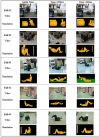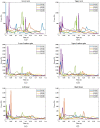Impact forces in backward falls: Subject-specific video-based rigid body simulation of backward falls
- PMID: 37969107
- PMCID: PMC10685694
- DOI: 10.1177/09544119231207653
Impact forces in backward falls: Subject-specific video-based rigid body simulation of backward falls
Abstract
A critical missing component in the study of real-world falls is the ability to accurately determine impact forces resulting from the fall. Subject-specific rigid body dynamic (RBD) models calibrated to video captured falls can quantify impact forces and provide additional insights into injury risk factors. RBD models were developed based on five backward falls captured on surveillance video in long-term care facilities in British Columbia, Canada. Model joint stiffness and initial velocities were calibrated to match the kinematics of the fall and contact forces were calculated. The effect of joint stiffnesses (neck, lumbar spine, hip, and knee joint) on head contact forces were determined by modifying the calibrated stiffness values ±25%. Fall duration, fall trajectories, and maximum velocities showed a close match between fall events and simulations. The maximum value of pelvic velocity difference between Kinovea (an open-source software 2D digitization software) and Madymo multibody modeling was found to be 6% ± 21.58%. Our results demonstrate that neck and hip stiffness values have a non-significant yet large effect on head contact force (t(3) = 1, p = 0.387 and t(3) = 2, p = 0.138), while lower effects were observed for knee stiffness, and the effect of lumbar spine stiffness was negligible. The subject-specific fall simulations constructed from real world video captured falls allow for direct quantification of force outcomes of falls and may have applications in improving the assessment of fall-induced injury risks and injury prevention methods.
Keywords: Fall; Madymo; joint stiffness; older adults’ fall; rigid body dynamics.
Conflict of interest statement
Declaration of conflicting interestsThe author(s) declared no potential conflicts of interest with respect to the research, authorship, and/or publication of this article.
Figures







Similar articles
-
Kinematic analysis of video-captured falls experienced by older adults in long-term care.J Biomech. 2015 Apr 13;48(6):911-20. doi: 10.1016/j.jbiomech.2015.02.025. Epub 2015 Feb 24. J Biomech. 2015. PMID: 25769730
-
Accuracy of Kinovea software in estimating body segment movements during falls captured on standard video: Effects of fall direction, camera perspective and video calibration technique.PLoS One. 2021 Oct 25;16(10):e0258923. doi: 10.1371/journal.pone.0258923. eCollection 2021. PLoS One. 2021. PMID: 34695159 Free PMC article.
-
Leg Joint Stiffness Affects Dynamics of Backward Falling From Standing Height: A Simulation Work.J Biomech Eng. 2020 Oct 1;142(10):101007. doi: 10.1115/1.4047077. J Biomech Eng. 2020. PMID: 32346720
-
Sideways fall-induced impact force and its effect on hip fracture risk: a review.Osteoporos Int. 2017 Oct;28(10):2759-2780. doi: 10.1007/s00198-017-4138-5. Epub 2017 Jul 20. Osteoporos Int. 2017. PMID: 28730547 Review.
-
Shock-absorbing flooring for fall-related injury prevention in older adults and staff in hospitals and care homes: the SAFEST systematic review.Health Technol Assess. 2022 Jan;26(5):1-196. doi: 10.3310/ZOWL2323. Health Technol Assess. 2022. PMID: 35089119
Cited by
-
Investigating the impact of dehydration and hydration on In-Vivo hip soft tissue biomechanics.PLoS One. 2025 Aug 12;20(8):e0328054. doi: 10.1371/journal.pone.0328054. eCollection 2025. PLoS One. 2025. PMID: 40794698 Free PMC article.
References
-
- Blake AJ, Morgan K, Bendall MJ, et al.. Falls by elderly people at home: prevalence and associated factors. Age Ageing 1988; 17: 365–372. - PubMed
-
- Hwang HF, Cheng CH, Chien DK, et al.. Risk factors for traumatic brain injuries during falls in older persons. J Head Trauma Rehabil 2015; 30: E9–E17. - PubMed
-
- Sarvi MN, Luo Y, Sun P, et al.. Experimental validation of subject-specific dynamics model for predicting impact force in Sideways Fall. J Biomed Sci Eng 2014; 07: 405–418. 2014.
-
- Choi WJ, Wakeling JM, Robinovitch SN. Kinematic analysis of video-captured falls experienced by older adults in long-term care. J Biomech 2015; 48: 911–920. - PubMed
MeSH terms
LinkOut - more resources
Full Text Sources

